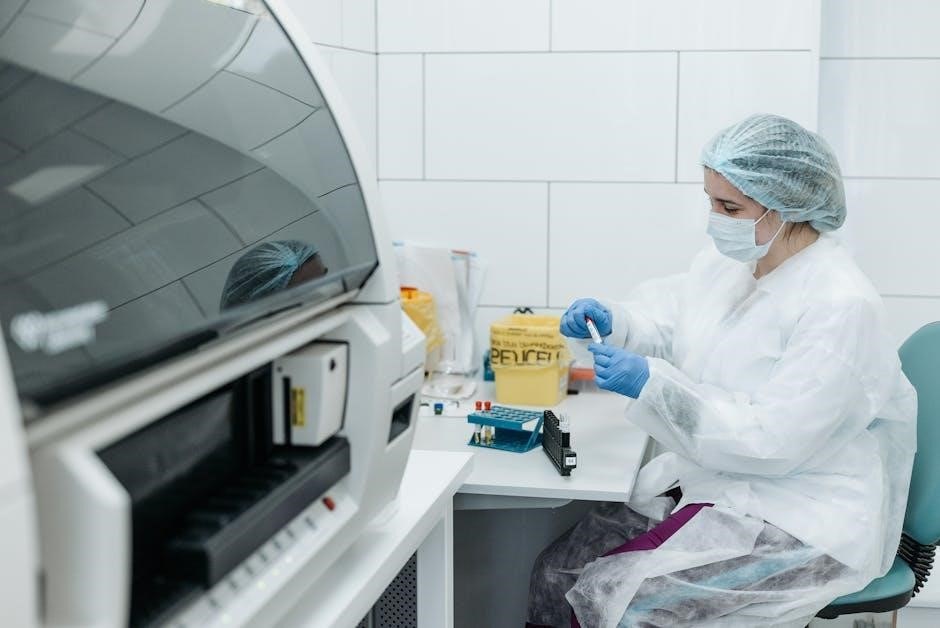
What Are Blood Types?
Blood type genetics is the study of the ABO blood group system, which determines an individual’s blood type based on the presence of specific antigens.
Antigens and Antibodies in Blood
Antigens on red blood cells (A and B) and antibodies in plasma (anti-A and anti-B) determine blood type, influencing compatibility in transfusions.
The Importance of Understanding Blood Type Genetics
Understanding blood type genetics is crucial for medicine, as it ensures safe transfusions and identifies universal donors, like Type O, who can donate to anyone.
Blood types are classified into four main categories: A, B, AB, and O. These types are determined by the presence or absence of specific antigens on the surface of red blood cells. Antigens are proteins that can trigger an immune response if they are foreign to the body. In the ABO blood group system, the A antigen is present in Type A blood, the B antigen in Type B, both in Type AB, and neither in Type O. Understanding blood types is fundamental for genetics studies, as it helps predict inheritance patterns and ensures safe blood transfusions. Worksheets and answer keys provide practical tools for mastering these concepts, making them essential for students learning blood type genetics.
Antigens are proteins found on the surface of red blood cells, while antibodies are immune proteins in the plasma that react to foreign antigens. In blood type genetics, the A and B antigens determine an individual’s blood type. People with Type A blood have A antigens and anti-B antibodies, while those with Type B have B antigens and anti-A antibodies. Individuals with Type AB blood have both A and B antigens and no antibodies, making them universal recipients. Conversely, Type O blood lacks both A and B antigens but has both anti-A and anti-B antibodies, qualifying them as universal donors. The interaction between antigens and antibodies is critical for blood type determination and transfusion compatibility, as mismatches can lead to agglutination, a potentially life-threatening reaction.
Understanding blood type genetics is essential for advancing medical science and ensuring safe blood transfusions. It helps identify universal donors and recipients, preventing life-threatening reactions. Blood type genetics also aids in solving inheritance puzzles, allowing families to predict offspring’s blood types. This knowledge is vital for personalized medicine, enabling tailored treatments and minimizing risks. By studying blood type genetics, healthcare professionals can better manage transfusion strategies and improve patient outcomes. Additionally, it provides insights into hereditary factors, empowering individuals to make informed decisions about their health. The practical applications of blood type genetics make it a cornerstone of modern medical practice and genetic education.

The Genetics Behind Blood Types

Blood types are determined by the ABO system, involving alleles A, B, and O. Codominance of A and B alleles results in the AB blood type.
The ABO Blood Group System
The ABO blood group system determines blood types based on the presence or absence of A and B antigens on red blood cells. The system involves three alleles: IA, IB, and i. IA and IB are dominant, while i is recessive. Codominance allows both A and B antigens to be expressed in individuals with IA and IB alleles, resulting in the AB blood type. When IA or IB is paired with i, the dominant allele determines the phenotype, producing A or B blood types. The ii genotype results in type O blood, lacking both A and B antigens. This system is crucial for understanding blood type inheritance and transfusion compatibility, as it explains why certain blood types can or cannot safely donate to or receive blood from others.
Alleles and Codominance in Blood Type Inheritance
Blood type inheritance involves three alleles: IA, IB, and i. IA and IB are dominant, while i is recessive. Codominance occurs when both IA and IB alleles are present, resulting in the AB blood type, where both A and B antigens are expressed. When IA or IB is paired with i, the dominant allele determines the phenotype, producing A or B blood types. The ii genotype results in type O blood, lacking both A and B antigens. This system explains why certain blood types can or cannot donate to or receive blood from others, making it fundamental for transfusion compatibility and genetic analysis. Understanding alleles and codominance is essential for predicting blood type inheritance patterns in families and solving genetic puzzles.
Genotype and Phenotype in Blood Type Determination
In blood type genetics, the genotype refers to the specific alleles an individual carries, while the phenotype is the physical expression of those alleles as a blood type. The possible genotypes are IAIA (Type A), IAi (Type A), IBIB (Type B), IBi (Type B), IAIB (Type AB), and ii (Type O). The phenotype is determined by the presence of A and B antigens on red blood cells. For example, IAIA and IAi both result in Type A blood, while IBIB and IBi result in Type B. The IAIB genotype produces Type AB, and ii results in Type O. Understanding the relationship between genotype and phenotype is crucial for predicting blood type inheritance and ensuring compatibility in medical procedures like transfusions.

Determining Blood Types
Blood types are determined by the ABO blood group system, which classifies blood into A, B, AB, and O based on antigen presence. Punnett squares predict genetic inheritance.
Using Punnett Squares to Predict Blood Types
Punnett squares are a fundamental tool for predicting the blood type of offspring based on the genetic information of the parents. Each parent contributes one allele (A, B, or O) to their child, and the Punnett square visually represents all possible combinations of these alleles. For example, if one parent is AO (Type A) and the other is BO (Type B), the square will show the potential genotypes (AO, BO, or OO) and phenotypes (A, B, or O) of their children. By analyzing the square, the probability of each blood type can be determined. This method is essential for understanding inheritance patterns and solving genetics problems, making it a key component of blood type worksheets and answer keys. It simplifies complex genetic concepts into a clear, visual format for easier comprehension.
Genotype-to-Phenotype Correlations in Blood Types
In blood type genetics, the genotype determines the phenotype through specific allele combinations. The A and B alleles are codominant, while O is recessive. Genotypes like AA or AO result in Type A blood, BB or BO in Type B, AB in Type AB, and OO in Type O. This correlation is crucial for predicting blood types in offspring and understanding compatibility. Worksheets and answer keys often detail these relationships, helping students master how genotypes translate to observable blood types. This knowledge is vital for medical applications, such as transfusions, and for solving genetic puzzles. By studying these correlations, learners can better grasp how genes influence blood type traits and their inheritance patterns across generations.
Common Blood Type Combinations in Parents and Offspring
Blood type combinations in parents and offspring are determined by the alleles they inherit. For example, parents with Type O blood (OO genotype) can only have children with Type O blood. If one parent is Type A (AO or AA) and the other is Type B (BO or BB), their children may inherit A, B, AB, or O blood types, depending on the alleles passed down. Worksheets often include Punnett squares to visualize these probabilities. Understanding these combinations is essential for predicting offspring blood types and solving genetic puzzles. Resources like answer keys provide clear explanations and examples, helping students master the inheritance patterns of blood types. This knowledge is vital for medical applications and genetic counseling.

Practical Blood Type Problems
Practical blood type problems involve determining possible offspring blood types and calculating probabilities using Punnett squares. Worksheets and answer keys provide structured examples and solutions for these genetic puzzles.
Determining Possible Blood Types of Offspring
Determining possible blood types of offspring involves analyzing the genetic combinations of alleles from each parent. Using Punnett squares, parents’ genotypes predict the probability of their children’s blood types. For example, a father with AB blood (genotype AB) and a mother with A blood (genotype AA or AO) can have children with A or AB blood types. Similarly, parents with type A and B blood can produce offspring with A, B, AB, or O blood types, depending on their genotypes. Worksheets and answer keys provide structured examples and solutions for these genetic puzzles, helping students master blood type inheritance patterns. These tools clarify how codominance and recessive alleles influence offspring’s blood type probabilities.
Calculating the Probability of Specific Blood Types
Calculating the probability of specific blood types involves using genetic principles and Punnett squares to predict offspring outcomes. Parents’ genotypes determine the alleles passed to their children. For example, a father with type A (AA or AO) and a mother with type B (BB or BO) can produce offspring with A, B, AB, or O blood types. Worksheets and answer keys provide step-by-step solutions, making it easier to calculate probabilities. These tools often include charts and tables to simplify the process. By analyzing the genetic combinations, students can determine the likelihood of each blood type in future generations. This method ensures accurate predictions and enhances understanding of blood type inheritance patterns.
Solving Blood Type Genetics Puzzles
Solving blood type genetics puzzles involves applying genetic principles to determine unknown blood types or predict inheritance patterns. Worksheets and answer keys provide structured problems, such as identifying possible genotypes based on phenotypes or calculating offspring probabilities. For example, if a child has type O blood, parents must contribute recessive alleles, narrowing their genotypes. Punnett squares are essential tools for visualizing allele combinations and predicting outcomes. These exercises enhance critical thinking and understanding of codominance in blood type genetics. Answer keys offer solutions, helping learners verify their work and master complex scenarios, such as determining a mother’s genotype when the father’s blood type is unknown.

Blood Type Compatibility and Transfusions
Blood type compatibility is crucial for safe transfusions. Universal donors (Type O) can donate to anyone, while universal recipients (Type AB) can receive from all types. Compatibility charts guide transfusions to prevent agglutination, which can be life-threatening if mismatched blood types are used.
Universal Donors and Universal Recipients
Universal donors and recipients are critical in blood transfusions. Type O negative blood is the universal donor, as it lacks A and B antigens, making it compatible with all blood types. This unique characteristic allows Type O negative individuals to donate blood to anyone in emergency situations. On the other hand, Type AB positive is the universal recipient, capable of receiving blood from all ABO blood types due to the absence of antibodies against A or B antigens. Understanding these roles is vital for safe medical practices, ensuring compatibility and preventing adverse reactions. Universal donors and recipients play a lifesaving role in transfusions, particularly when time is critical and blood typing is not immediately possible.
Compatibility Charts for Blood Transfusions
Compatibility charts are essential tools for determining safe blood transfusions. These charts outline which blood types can donate to or receive blood from others. The ABO blood group system dictates compatibility based on the presence of antigens and antibodies. For example, Type O blood can donate to any blood type because it lacks A and B antigens, while Type AB can receive from all types due to the absence of antibodies. Donor-recipient compatibility is critical to prevent adverse reactions. Charts typically show that Type A can donate to A and AB, Type B to B and AB, and Type AB only to AB. Understanding these charts ensures safe transfusions and is a cornerstone of blood bank operations. They are widely used in medical settings to avoid immunological conflicts and save lives.
Consequences of Incompatible Blood Transfusions
Incompatible blood transfusions can lead to severe and potentially life-threatening reactions. When the wrong blood type is transfused, the recipient’s immune system recognizes the foreign antigens as harmful, triggering an immune response. This reaction can cause agglutination, where red blood cells clump together and block blood vessels. Symptoms include chest pain, shortness of breath, and fever. In severe cases, it can result in kidney failure, shock, or even death. The antibodies in the recipient’s plasma attack the donated blood cells, leading to their destruction. This highlights the critical importance of ensuring blood type compatibility before any transfusion occurs. Proper matching of donor and recipient blood types is essential to prevent these dangerous complications.

Resources for Blood Type Genetics
Worksheets and answer keys on blood type genetics are widely available online, offering practice problems and solutions to master blood type inheritance and compatibility.
Where to Find Blood Type Genetics Worksheets
Blood type genetics worksheets with answer keys are available online, offering practice problems and solutions. Popular platforms include educational websites, PDF repositories, and biology resource hubs. Many schools and universities provide these worksheets for students to practice blood type inheritance and compatibility. Websites like ScienceOfBioGenetics.com and EducationWorksheets.com offer downloadable PDF templates. Additionally, online tools like Google Classroom and Khan Academy host similar resources. Search terms such as “Blood Type Genetics Worksheet PDF” or “Blood Type Problems Worksheet with Answer Key” yield numerous results. These resources are invaluable for mastering blood type genetics, ensuring a comprehensive understanding of inheritance patterns and transfusion compatibility.
How to Use Answer Keys Effectively
Answer keys for blood type genetics worksheets are essential for self-assessment and understanding complex concepts. Start by completing the worksheet independently, then compare your answers with the key to identify mistakes. Review incorrect answers thoroughly, ensuring comprehension of the underlying principles. Use the key to verify genotypes, phenotypes, and Punnett square predictions. For example, if determining possible offspring blood types, cross-check with the key to confirm accuracy. Regularly reviewing answer keys helps reinforce learning and improves problem-solving skills. Over time, this practice enhances mastery of blood type inheritance and compatibility, making complex genetics problems more approachable and manageable. Consistent use of answer keys ensures a solid foundation in blood type genetics.
Online Tools for Blood Type Genetics Practice
Several online tools are available to practice and master blood type genetics. Websites offer interactive simulations, such as Punnett square generators, to predict offspring blood types. Additionally, downloadable worksheets and answer keys in PDF format provide structured exercises. Some platforms include quizzes and games to make learning engaging. These tools allow students to explore genetic inheritance, test hypotheses, and visualize blood type compatibility. For instance, virtual labs simulate blood transfusions, showing the consequences of incompatible donations. Online forums and tutorials also offer step-by-step guidance for solving complex genetics problems. Utilizing these resources enhances understanding and retention of blood type genetics concepts, making them invaluable for both students and educators. Regular practice with these tools ensures proficiency in blood type inheritance and compatibility.
Blood type genetics is vital in medicine, ensuring safe transfusions and understanding heredity. Mastering this topic aids in solving genetic puzzles and applying knowledge in real-world scenarios.
The Significance of Blood Type Genetics in Medicine
Blood type genetics plays a critical role in medicine, particularly in transfusions and donor compatibility. Understanding the ABO system helps prevent life-threatening reactions by ensuring blood compatibility. Antigens and antibodies must align between donors and recipients to avoid agglutination, which can be fatal. Blood type O, lacking A and B antigens, is the universal donor, making it essential in emergencies. Conversely, AB individuals are universal recipients, able to receive any blood type. This knowledge is vital for blood banks, surgical planning, and emergency care. It also aids in tracing parentage and studying population genetics. Mastery of blood type genetics ensures safe medical practices and highlights the importance of genetic diversity in healthcare.
Final Tips for Mastering Blood Type Genetics
To master blood type genetics, start by practicing with Punnett squares to predict offspring blood types. Focus on understanding codominance and how alleles (A, B, O) interact. Use worksheets and answer keys to reinforce concepts like genotype-to-phenotype correlations. Pay attention to universal donors (Type O) and universal recipients (Type AB) for transfusions. Apply genetic principles to real-world scenarios, such as solving inheritance puzzles or determining compatibility. Regularly review antigen-antibody reactions and their medical implications. Engage with online tools and resources to test your knowledge. By combining theoretical understanding with practical exercises, you’ll gain confidence in blood type genetics and its applications in medicine and genetics problems.
Leave a Reply
You must be logged in to post a comment.